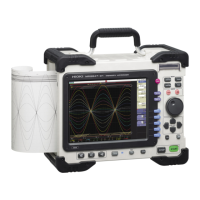2.7 Adjusting the Zero Position (Zero-Adjust)
36
This procedure compensates for input module differences and sets the reference potential of the
instrument to 0 V.
The compensation applies to the selected range.
Perform zero-adjust in the following cases.
• When an input module was changed.
• When power was turned off and on again.
• When settings were initialized (system reset).
• When DC/RMS is switched at the 8971 Current Unit and the 8972 DC/RMS
Unit
• When the ambient temperature has changed significantly.
Zero-position drift
*
may occur.
* Drift: This refers to spurious output caused by a shift in the operating point of an opera-
tional amprifier. Drift can occur due to changes in temperature and due to compo-
nent aging over a period of use.
2.7 Adjusting the Zero Position (Zero-Adjust)
• To obtain precise measurements, provide about 30 minutes warm-up after turning power on to allow
the internal temperature of the input modules to stabilize.
• Note that zero-adjust cannot be performed during a measurement.
• During zero-adjust, the operation keys of the unit are inactive. (The procedure may take several sec-
onds.)
Before starting zero-adjust
Procedure
To open the screen: Press the CHAN key → [Unit List] sheet
1
Move the cursor to the [Zero-Adjust] item.
2
Select [Exec Zero-Adjust].
The zero-adjust procedure is carried out.
Zero-adjust has no effect on the 8969 Strain Unit. (Perform zero-adjust using
Auto Balance. ( p.144))

